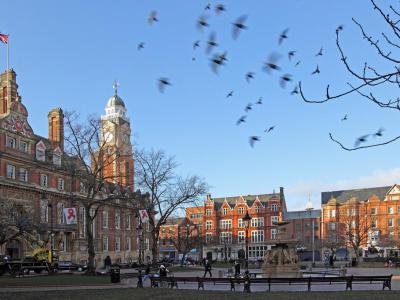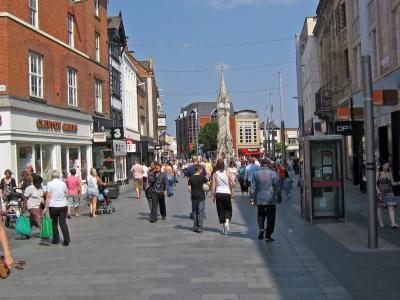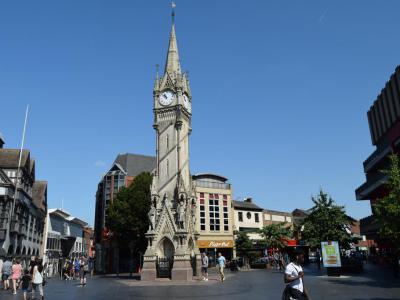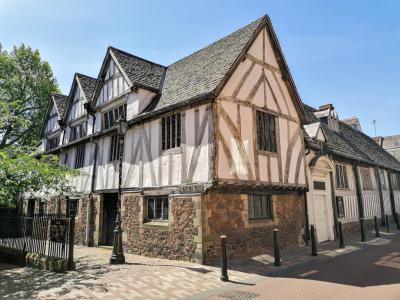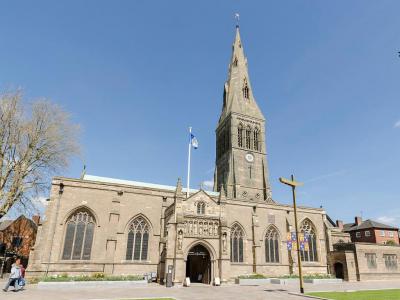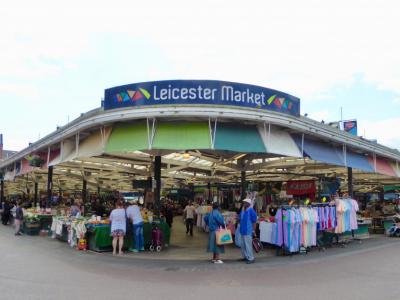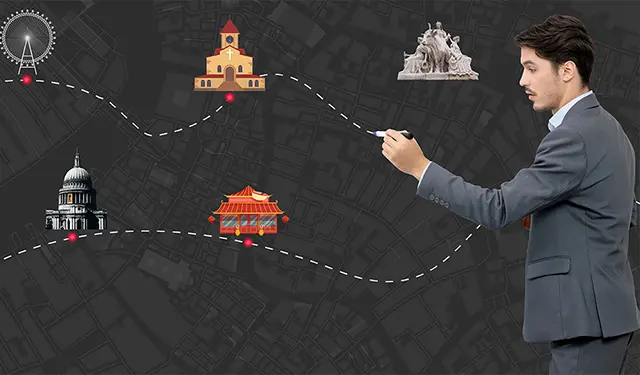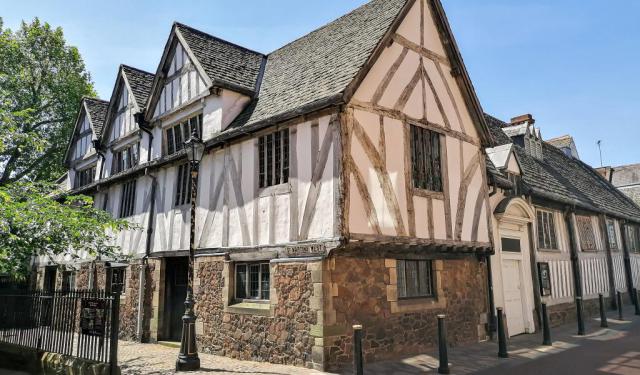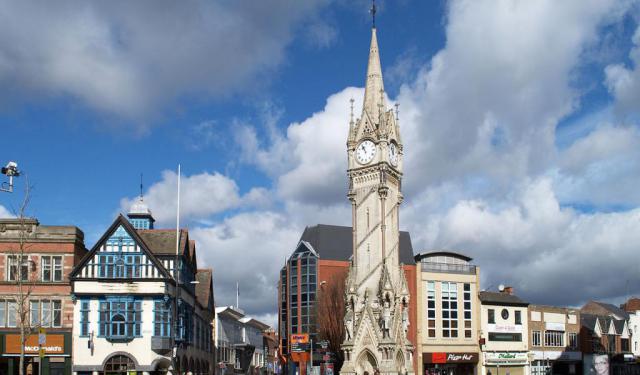
Leicester Introduction Walking Tour (Self Guided), Leicester
Leicester is one of the oldest cities in England, whose history goes back almost two millennia. The Romans arrived in the area around 47 AD, during their conquest of southern Britain. Following the Saxon invasion, Leicester was then captured by Danish Vikings, in the 9th century.
The settlement was first documented in the early 10th century, under the name Ligeraceaster. At the time of the Norman Conquest in 1066, the town, then known as Ledecestre, was quite thriving. William the Conqueror's Domesday Book recorded it as having 322 houses and six churches, with a population of between 1,500 and 2,000. Medieval Leicester lay within the old Roman walls which followed the lines of today's Soar Lane, Sanvey Gate, Church Gate, Gallowtree Gate, Horsefair Street and Bath Lane.
The name Leicester comes from Old English and derives from Latin “Legorensis civitatis”. The former word is the name of a people, the Ligore, who came from the river Ligor (now the River Soar). The second element of the name is the Old English word ceaster which means "fort, fortification, town" (borrowed from Latin castrum).
In the 12th-13th centuries Leicester underwent a development boom, and in the 14th century saw its prestige further enhanced. The timber-framed Leicester Guildhall (once acted as the town hall) dates from that period. At the end of the War of the Roses (mid-to-late 15th century), King Richard III met his end at the Battle of Bosworth Field near the town, and was buried in Leicester's Greyfriars Church. The burial site, demolished in 1538, was discovered in 2012 and is now covered by King Richard III Visitor Centre.
During the Industrial era, particularly throughout the reign of Queen Victoria, Leicester had prospered greatly. Between 1861 and 1901, its population had increased three-fold, to exceed 210,000, with the living conditions also generally improved.
Leicester was finally recognized as a city in 1919 for its contribution to the British WWI effort. In 1927, Leicester became a cathedral city upon the consecration of St Martin's Church as Leicester Cathedral. The years after WWII, particularly from the 1960s onwards, brought many social and economic challenges to the city, as well as further expansion.
To check out Leicester's major attractions worthy of attention, take this self-guided walk and learn more about the past and present of this city in its variety!
The settlement was first documented in the early 10th century, under the name Ligeraceaster. At the time of the Norman Conquest in 1066, the town, then known as Ledecestre, was quite thriving. William the Conqueror's Domesday Book recorded it as having 322 houses and six churches, with a population of between 1,500 and 2,000. Medieval Leicester lay within the old Roman walls which followed the lines of today's Soar Lane, Sanvey Gate, Church Gate, Gallowtree Gate, Horsefair Street and Bath Lane.
The name Leicester comes from Old English and derives from Latin “Legorensis civitatis”. The former word is the name of a people, the Ligore, who came from the river Ligor (now the River Soar). The second element of the name is the Old English word ceaster which means "fort, fortification, town" (borrowed from Latin castrum).
In the 12th-13th centuries Leicester underwent a development boom, and in the 14th century saw its prestige further enhanced. The timber-framed Leicester Guildhall (once acted as the town hall) dates from that period. At the end of the War of the Roses (mid-to-late 15th century), King Richard III met his end at the Battle of Bosworth Field near the town, and was buried in Leicester's Greyfriars Church. The burial site, demolished in 1538, was discovered in 2012 and is now covered by King Richard III Visitor Centre.
During the Industrial era, particularly throughout the reign of Queen Victoria, Leicester had prospered greatly. Between 1861 and 1901, its population had increased three-fold, to exceed 210,000, with the living conditions also generally improved.
Leicester was finally recognized as a city in 1919 for its contribution to the British WWI effort. In 1927, Leicester became a cathedral city upon the consecration of St Martin's Church as Leicester Cathedral. The years after WWII, particularly from the 1960s onwards, brought many social and economic challenges to the city, as well as further expansion.
To check out Leicester's major attractions worthy of attention, take this self-guided walk and learn more about the past and present of this city in its variety!
How it works: Download the app "GPSmyCity: Walks in 1K+ Cities" from Apple App Store or Google Play Store to your mobile phone or tablet. The app turns your mobile device into a personal tour guide and its built-in GPS navigation functions guide you from one tour stop to next. The app works offline, so no data plan is needed when traveling abroad.
Leicester Introduction Walking Tour Map
Guide Name: Leicester Introduction Walking Tour
Guide Location: England » Leicester (See other walking tours in Leicester)
Guide Type: Self-guided Walking Tour (Sightseeing)
# of Attractions: 8
Tour Duration: 1 Hour(s)
Travel Distance: 1.1 Km or 0.7 Miles
Author: Ella
Sight(s) Featured in This Guide:
Guide Location: England » Leicester (See other walking tours in Leicester)
Guide Type: Self-guided Walking Tour (Sightseeing)
# of Attractions: 8
Tour Duration: 1 Hour(s)
Travel Distance: 1.1 Km or 0.7 Miles
Author: Ella
Sight(s) Featured in This Guide:
- Town Hall Square
- Gallowtree Gate
- Haymarket Memorial Clock Tower
- High Street
- The Guildhall
- Leicester Cathedral
- King Richard III Visitor Centre
- Leicester Market
1) Town Hall Square
Town Hall Square is a central civic space in Leicester, home to the grand Leicester Town Hall and its striking ornamental fountain. A welcoming public space, the square is an architectural and historical highlight of the city, reflecting Leicester’s evolution from a medieval market town to a modern urban center.
The Leicester Town Hall, a Grade II* listed building, was constructed on the site of the city’s old cattle market after the Guildhall—Leicester’s previous council meeting place—was deemed too small. Designed by architect Francis Hames in the Queen Anne style, the foundation stone was laid on 3 August 1874, and the building officially opened on 7 August 1876. The structure, made from Ketton stone, features an imposing 44-meter-high clock tower and has undergone extensions in 1910 and 1924. A notable event in its history occurred during the Blitz in 1940 when a German bomb crashed through the roof and into the basement, remarkably failing to detonate.
One of the most distinctive features of the square is its grand fountain, a gift from Sir Israel Hart, a former Mayor of Leicester. Unveiled in 1879, the fountain, designed by Hames, incorporates bronze-painted cast iron, Shap granite, and Ross of Mull granite. Though it was once believed to be inspired by a similar fountain in Porto, Portugal, evidence suggests the Leicester fountain predates the Porto version, with strong indications that the latter was a copy.
Town Hall Square is also home to the Second Boer War Memorial, sculpted by Joseph Crosland McClure and unveiled in 1909 by Field Marshal Lord Grenfell. This monument stands as a tribute to Leicester’s military history.
Beyond its historical significance, the square remains a focal point of civic life, housing Leicester City Council and offering a pleasant urban space for residents and visitors alike.
The Leicester Town Hall, a Grade II* listed building, was constructed on the site of the city’s old cattle market after the Guildhall—Leicester’s previous council meeting place—was deemed too small. Designed by architect Francis Hames in the Queen Anne style, the foundation stone was laid on 3 August 1874, and the building officially opened on 7 August 1876. The structure, made from Ketton stone, features an imposing 44-meter-high clock tower and has undergone extensions in 1910 and 1924. A notable event in its history occurred during the Blitz in 1940 when a German bomb crashed through the roof and into the basement, remarkably failing to detonate.
One of the most distinctive features of the square is its grand fountain, a gift from Sir Israel Hart, a former Mayor of Leicester. Unveiled in 1879, the fountain, designed by Hames, incorporates bronze-painted cast iron, Shap granite, and Ross of Mull granite. Though it was once believed to be inspired by a similar fountain in Porto, Portugal, evidence suggests the Leicester fountain predates the Porto version, with strong indications that the latter was a copy.
Town Hall Square is also home to the Second Boer War Memorial, sculpted by Joseph Crosland McClure and unveiled in 1909 by Field Marshal Lord Grenfell. This monument stands as a tribute to Leicester’s military history.
Beyond its historical significance, the square remains a focal point of civic life, housing Leicester City Council and offering a pleasant urban space for residents and visitors alike.
2) Gallowtree Gate
Leicester boasts plenty of intriguing street names, each with its own story. One such is Gallowtree Gate, a busy pedestrian street in the heart of the city, running between Horsefair Street and the Clock Tower at Church Gate and Haymarket.
The streets in this area are commonly referred to as gates, which is due to the fortress-like gates that once offered entrance into the city through the Roman walls. The four gates were originally named after the cardinal directions but were later renamed to reflect their usage. The word "gate", from the Norse "gata", describes passages that were in use starting from the year 868 when Danish Vikings captured the Midlands, then known as the Mercia region of Britain.
Nowadays lined with shops, cafes and numerous businesses, the history of Gallowtree Gate is very different from the street's modern image. The origins of the name stem from its use as a path to the gallows where public executions were held. Condemned prisoners would have walked along Gallowtree Gate to the gallows in London Road, where today the Victoria Park gates are. There, they were hanged by the neck until death in front of a crowd of onlookers. Gruesome!!!
The streets in this area are commonly referred to as gates, which is due to the fortress-like gates that once offered entrance into the city through the Roman walls. The four gates were originally named after the cardinal directions but were later renamed to reflect their usage. The word "gate", from the Norse "gata", describes passages that were in use starting from the year 868 when Danish Vikings captured the Midlands, then known as the Mercia region of Britain.
Nowadays lined with shops, cafes and numerous businesses, the history of Gallowtree Gate is very different from the street's modern image. The origins of the name stem from its use as a path to the gallows where public executions were held. Condemned prisoners would have walked along Gallowtree Gate to the gallows in London Road, where today the Victoria Park gates are. There, they were hanged by the neck until death in front of a crowd of onlookers. Gruesome!!!
3) Haymarket Memorial Clock Tower
The Haymarket Memorial Clock Tower is one of Leicester’s most recognizable landmarks and a favored meeting spot. Positioned near the city center within the ring road, it marks the convergence of five key streets: Gallowtree Gate, Humberstone Gate, Belgrave Gate, Church Gate, and Eastgates, with Cheapside also nearby. For generations, it has been the go-to rendezvous point in the heart of the city.
Before the Clock Tower’s construction, the site housed an Assembly Room built in 1750, later repurposed into shops in 1805. Over time, it gained a reputation as "the Haymarket Obstruction," prompting local property owners to campaign for its removal. The building was demolished in 1862, though the hay market remained in place until it was eventually moved to Humberstone Gate.
Clearing the site left a broad open space that became increasingly difficult for pedestrians to navigate due to heavy traffic. Meanwhile, plans for an illuminated clock at the London Road and Belvoir Street junction sparked local businesses to petition for a striking alternative: a grand clock with lamps and a statue of Sir Thomas White, a well-known local benefactor.
Completed in 1868, the Clock Tower was built primarily from Ketton stone, with a Mountsorrel granite base. It features polished Peterhead granite and serpentine columns, while its statues were sculpted from Portland stone. Notably, the tower was erected above the intersection of two major city sewers, which had to be modified before construction could begin.
As a memorial, the Clock Tower honors four notable figures from Leicester’s history, each represented by a statue at its corners: Simon de Montfort, William Wyggeston (spelled 'Wigston' on the tower), Thomas White, and Gabriel Newton.
Before the Clock Tower’s construction, the site housed an Assembly Room built in 1750, later repurposed into shops in 1805. Over time, it gained a reputation as "the Haymarket Obstruction," prompting local property owners to campaign for its removal. The building was demolished in 1862, though the hay market remained in place until it was eventually moved to Humberstone Gate.
Clearing the site left a broad open space that became increasingly difficult for pedestrians to navigate due to heavy traffic. Meanwhile, plans for an illuminated clock at the London Road and Belvoir Street junction sparked local businesses to petition for a striking alternative: a grand clock with lamps and a statue of Sir Thomas White, a well-known local benefactor.
Completed in 1868, the Clock Tower was built primarily from Ketton stone, with a Mountsorrel granite base. It features polished Peterhead granite and serpentine columns, while its statues were sculpted from Portland stone. Notably, the tower was erected above the intersection of two major city sewers, which had to be modified before construction could begin.
As a memorial, the Clock Tower honors four notable figures from Leicester’s history, each represented by a statue at its corners: Simon de Montfort, William Wyggeston (spelled 'Wigston' on the tower), Thomas White, and Gabriel Newton.
4) High Street
High Street is a main pedestrian street in the center of Leicester. It is lined with numerous shops and boutiques selling high-end jewelry, clothing, stationery and even groceries. There are also varied restaurants and cafes to be found here, whose patrons can enjoy anything from beer on tap to a kebab to Kentucky Fried Chicken.
Though mostly known for shopping, High Street also has some entertainment venues and interesting architecture. The grand mansion known as Lord’s Place (43-51 High Street), nowadays a residential and office space with boutique shopping on the street level, was once home of Henry, Earl of Huntingdon, from 1569. It is also said that Mary, Queen of Scots, stayed there in 1586, followed by King James I in 1612 and Charles I in 1642. A plaque on No. 45 High Street records the site’s history.
High Street follows a route that existed in Roman times, connecting East Gate to the Forum and Basilica (now Jubilee Square). In medieval times it was known as Forum Porcorum (‘pig market’) or Swinesmarket, but was renamed High Street in 1524 to reflect its increased importance.
In 1899 the construction of the Great Central Railway further increased the importance of High Street, which linked the commercial heart of Leicester with the new station. The street had to be widened to accommodate Leicester’s new electric tram system and many of its buildings were demolished and replaced. Replacement buildings that have survived include No. 7, a classical style bank (1904), No. 40, Leicester’s first cinema, the Electric Theatre (1910), Nos. 58-60, Butler’s Chemist’s Shop and Nos. 76-88, the Coronation Buildings (1904).
Though mostly known for shopping, High Street also has some entertainment venues and interesting architecture. The grand mansion known as Lord’s Place (43-51 High Street), nowadays a residential and office space with boutique shopping on the street level, was once home of Henry, Earl of Huntingdon, from 1569. It is also said that Mary, Queen of Scots, stayed there in 1586, followed by King James I in 1612 and Charles I in 1642. A plaque on No. 45 High Street records the site’s history.
High Street follows a route that existed in Roman times, connecting East Gate to the Forum and Basilica (now Jubilee Square). In medieval times it was known as Forum Porcorum (‘pig market’) or Swinesmarket, but was renamed High Street in 1524 to reflect its increased importance.
In 1899 the construction of the Great Central Railway further increased the importance of High Street, which linked the commercial heart of Leicester with the new station. The street had to be widened to accommodate Leicester’s new electric tram system and many of its buildings were demolished and replaced. Replacement buildings that have survived include No. 7, a classical style bank (1904), No. 40, Leicester’s first cinema, the Electric Theatre (1910), Nos. 58-60, Butler’s Chemist’s Shop and Nos. 76-88, the Coronation Buildings (1904).
5) The Guildhall (must see)
The Guildhall in Leicester is one of the city's most treasured historic buildings, with origins dating back to around 1390. A remarkable example of timber-framed architecture, it has served various civic and cultural functions over the centuries. Originally built as a meeting place for the Guild of Corpus Christi, a powerful group of local businessmen and gentry, the Guildhall later became the town hall of Leicester, a role it retained until a new town hall was commissioned in 1876.
Located in the old walled city, on what is now known as Guildhall Lane, the building has witnessed many pivotal moments in English history. During the English Civil War, the Guildhall was looted by Royalist troops, and it was here that the city's leaders discussed the Royalist ultimatum. When the Spanish Armada was defeated in 1588, Leicester’s celebrations were held within its walls. The building also played a role in Leicester’s legal and policing history, serving as a courtroom, jail, and the city's first police station.
The Guildhall has long been a cultural and intellectual hub. In 1632, it became the city’s library, making it one of the oldest public libraries in England. The 16th century saw a growing enthusiasm for theatre, and it is believed that William Shakespeare himself performed at the Guildhall. Today, it continues to be a dynamic performance venue, hosting concerts, plays, comedy gigs, and exhibitions.
Now a museum, Leicester Guildhall offers visitors an immersive journey into the city’s medieval past. Its galleries explore the history of Leicester, while the Mayor’s Parlour showcases late-medieval stained glass. Visitors can also step inside the original jail cells, which house unsettling relics of the past, including historical torture devices. The Guildhall is also reputed to be haunted, with five resident ghosts said to linger within its walls—a claim that has drawn paranormal investigations, including TV’s 'Most Haunted.'
Located in the old walled city, on what is now known as Guildhall Lane, the building has witnessed many pivotal moments in English history. During the English Civil War, the Guildhall was looted by Royalist troops, and it was here that the city's leaders discussed the Royalist ultimatum. When the Spanish Armada was defeated in 1588, Leicester’s celebrations were held within its walls. The building also played a role in Leicester’s legal and policing history, serving as a courtroom, jail, and the city's first police station.
The Guildhall has long been a cultural and intellectual hub. In 1632, it became the city’s library, making it one of the oldest public libraries in England. The 16th century saw a growing enthusiasm for theatre, and it is believed that William Shakespeare himself performed at the Guildhall. Today, it continues to be a dynamic performance venue, hosting concerts, plays, comedy gigs, and exhibitions.
Now a museum, Leicester Guildhall offers visitors an immersive journey into the city’s medieval past. Its galleries explore the history of Leicester, while the Mayor’s Parlour showcases late-medieval stained glass. Visitors can also step inside the original jail cells, which house unsettling relics of the past, including historical torture devices. The Guildhall is also reputed to be haunted, with five resident ghosts said to linger within its walls—a claim that has drawn paranormal investigations, including TV’s 'Most Haunted.'
6) Leicester Cathedral (must see)
Leicester Cathedral, officially known as the Cathedral Church of Saint Martin, is one of England’s smallest Anglican cathedrals. Despite its modest size, it holds immense historical significance, most notably as the final resting place of King Richard III, whose remains were discovered in a nearby car park in 2012 and ceremonially reburied in the cathedral in 2015.
The cathedral stands on a site with deep historical roots, originally occupied by Roman structures. It is dedicated to Saint Martin of Tours, a 4th-century Roman officer turned bishop. The earliest mention of a church here dates back to the Domesday Book of 1086, making it one of Leicester’s oldest religious sites. The structure originated as a 12th-century Norman church and was rebuilt in the 13th and 15th centuries, becoming Leicester’s civic church due to its ties to merchants, guilds, and the nearby Guild Hall.
While remnants of medieval architecture remain, much of the current building reflects Victorian restoration efforts. The soaring 220-foot spire and the tower, both designed by architect Raphael Brandon, were rebuilt in the 1860s. In 1927, the church was formally consecrated as Leicester’s cathedral following the re-establishment of the diocese, marking the return of a bishop to Leicester after more than a millennium.
Today, Leicester Cathedral attracts over 100,000 visitors annually, many drawn to the tomb of King Richard III. His remains were interred beneath a striking Swaledale fossil stone tomb, weighing three tonnes. The cathedral also houses the Pall, an embroidered cloth that adorned the king’s coffin during his reinterment. Created by artist Jacquie Binns, the Pall narrates Richard III’s life story and the extraordinary rediscovery of his remains.
Aside from its royal connections, the cathedral contains intriguing historical artifacts, including a set of 14th-century wooden carvings depicting figures afflicted with various ailments—one even sporting a medieval hearing aid. The interior also features a large wooden screen separating the nave from the chancel, designed by Charles Nicholson and crafted by Bowman of Stamford.
A Grade II* listed building, Leicester Cathedral remains a prominent landmark in the city, blending centuries of ecclesiastical history with modern commemorative significance. It stands not only as a place of worship but also as a testament to Leicester’s rich and layered past.
The cathedral stands on a site with deep historical roots, originally occupied by Roman structures. It is dedicated to Saint Martin of Tours, a 4th-century Roman officer turned bishop. The earliest mention of a church here dates back to the Domesday Book of 1086, making it one of Leicester’s oldest religious sites. The structure originated as a 12th-century Norman church and was rebuilt in the 13th and 15th centuries, becoming Leicester’s civic church due to its ties to merchants, guilds, and the nearby Guild Hall.
While remnants of medieval architecture remain, much of the current building reflects Victorian restoration efforts. The soaring 220-foot spire and the tower, both designed by architect Raphael Brandon, were rebuilt in the 1860s. In 1927, the church was formally consecrated as Leicester’s cathedral following the re-establishment of the diocese, marking the return of a bishop to Leicester after more than a millennium.
Today, Leicester Cathedral attracts over 100,000 visitors annually, many drawn to the tomb of King Richard III. His remains were interred beneath a striking Swaledale fossil stone tomb, weighing three tonnes. The cathedral also houses the Pall, an embroidered cloth that adorned the king’s coffin during his reinterment. Created by artist Jacquie Binns, the Pall narrates Richard III’s life story and the extraordinary rediscovery of his remains.
Aside from its royal connections, the cathedral contains intriguing historical artifacts, including a set of 14th-century wooden carvings depicting figures afflicted with various ailments—one even sporting a medieval hearing aid. The interior also features a large wooden screen separating the nave from the chancel, designed by Charles Nicholson and crafted by Bowman of Stamford.
A Grade II* listed building, Leicester Cathedral remains a prominent landmark in the city, blending centuries of ecclesiastical history with modern commemorative significance. It stands not only as a place of worship but also as a testament to Leicester’s rich and layered past.
7) King Richard III Visitor Centre (must see)
The King Richard III Visitor Centre is a museum dedicated to the dramatic story of England’s last Plantagenet king, from his life and reign to the extraordinary discovery of his remains centuries later. Located in Leicester, the center provides an in-depth exploration of Richard III’s legacy and the groundbreaking archaeological project that confirmed his final resting place.
For centuries, the location of Richard III’s burial remained uncertain, though historical records suggested he was laid to rest in the medieval Greyfriars friary after his death at the Battle of Bosworth Field in 1485. In 2012, a team from the University of Leicester Archaeological Services (ULAS), in collaboration with Philippa Langley and the Richard III Society, launched an excavation in a Leicester city car park, long believed to be the site of Greyfriars. Astonishingly, the king’s remains were discovered on the first day of the dig. DNA analysis later confirmed his identity, marking one of the most significant historical finds in British history.
Recognizing the global significance of the discovery, Leicester City Council transformed the former Alderman Newton's School, a Victorian-era building next to the excavation site, into a state-of-the-art visitor center. Opened on 26 July 2014, the center features exhibitions detailing Richard III’s turbulent reign, his portrayal in history, and the forensic science that led to his identification. A glass-floored viewing area allows visitors to see the original grave site within the friary’s choir.
The center’s design, led by architect Paul East of Maber Architects, skillfully integrates modern exhibition space with the historical significance of the site. The museum’s impact was further recognized in 2018, when it was awarded "Best Museum" in the Group Leisure and Travel Awards, triumphing over institutions like the British Museum and the National Railway Museum.
A compelling mix of history, science, and discovery, the King Richard III Visitor Centre offers an engaging experience for history enthusiasts and casual visitors alike, shedding new light on one of England’s most enigmatic monarchs.
For centuries, the location of Richard III’s burial remained uncertain, though historical records suggested he was laid to rest in the medieval Greyfriars friary after his death at the Battle of Bosworth Field in 1485. In 2012, a team from the University of Leicester Archaeological Services (ULAS), in collaboration with Philippa Langley and the Richard III Society, launched an excavation in a Leicester city car park, long believed to be the site of Greyfriars. Astonishingly, the king’s remains were discovered on the first day of the dig. DNA analysis later confirmed his identity, marking one of the most significant historical finds in British history.
Recognizing the global significance of the discovery, Leicester City Council transformed the former Alderman Newton's School, a Victorian-era building next to the excavation site, into a state-of-the-art visitor center. Opened on 26 July 2014, the center features exhibitions detailing Richard III’s turbulent reign, his portrayal in history, and the forensic science that led to his identification. A glass-floored viewing area allows visitors to see the original grave site within the friary’s choir.
The center’s design, led by architect Paul East of Maber Architects, skillfully integrates modern exhibition space with the historical significance of the site. The museum’s impact was further recognized in 2018, when it was awarded "Best Museum" in the Group Leisure and Travel Awards, triumphing over institutions like the British Museum and the National Railway Museum.
A compelling mix of history, science, and discovery, the King Richard III Visitor Centre offers an engaging experience for history enthusiasts and casual visitors alike, shedding new light on one of England’s most enigmatic monarchs.
8) Leicester Market
Leicester Market is a historic and vibrant market located in the heart of Leicester, just south of the iconic Clock Tower. With a history stretching back around 800 years, the market has occupied its current site for the last 700 years. It is Europe’s largest outdoor covered market, offering a diverse shopping experience.
The outdoor market features over 10 to 15 stalls, selling a wide variety of goods, particularly fresh fruit, and vegetables, alongside flowers, clothing, second-hand books, bric-a-brac, and jewelry. Several permanent units within the market provide additional shopping options, including clothes, cosmetics, fabrics, greeting cards, pet products, and a café.
The market was once home to an indoor section, constructed in 1973, which housed a fish market, delicatessen, and stalls selling clothing, haberdashery, footwear, jewelry, and confectionery. However, this indoor market was demolished between December 2014 and June 2015, with its site transformed into New Market Square.
At the center of the market stands the Leicester Corn Exchange (1850), originally a trading hub and now serving as a bar and restaurant. Nearby, a statue of John Manners, 5th Duke of Rutland, adds a historical touch to the market’s surroundings.
Additionally, a monthly Farmers' Market takes place on Gallowtree Gate on the last Wednesday of each month, focusing on locally produced organic meat, fruit, and vegetables.
Leicester Market, protected by a 700-year-old Royal Charter, traditionally restricted other markets within a 6⅔-mile radius. In recent years, the City Council has eased this rule, allowing new markets, including a proposed Sunday Market at Walkers Stadium in 2009, while preserving Leicester Market’s historic status.
Rich in history and commerce, Leicester Market remains a central part of the city’s identity, offering both traditional and modern retail experiences.
The outdoor market features over 10 to 15 stalls, selling a wide variety of goods, particularly fresh fruit, and vegetables, alongside flowers, clothing, second-hand books, bric-a-brac, and jewelry. Several permanent units within the market provide additional shopping options, including clothes, cosmetics, fabrics, greeting cards, pet products, and a café.
The market was once home to an indoor section, constructed in 1973, which housed a fish market, delicatessen, and stalls selling clothing, haberdashery, footwear, jewelry, and confectionery. However, this indoor market was demolished between December 2014 and June 2015, with its site transformed into New Market Square.
At the center of the market stands the Leicester Corn Exchange (1850), originally a trading hub and now serving as a bar and restaurant. Nearby, a statue of John Manners, 5th Duke of Rutland, adds a historical touch to the market’s surroundings.
Additionally, a monthly Farmers' Market takes place on Gallowtree Gate on the last Wednesday of each month, focusing on locally produced organic meat, fruit, and vegetables.
Leicester Market, protected by a 700-year-old Royal Charter, traditionally restricted other markets within a 6⅔-mile radius. In recent years, the City Council has eased this rule, allowing new markets, including a proposed Sunday Market at Walkers Stadium in 2009, while preserving Leicester Market’s historic status.
Rich in history and commerce, Leicester Market remains a central part of the city’s identity, offering both traditional and modern retail experiences.
Walking Tours in Leicester, England
Create Your Own Walk in Leicester
Creating your own self-guided walk in Leicester is easy and fun. Choose the city attractions that you want to see and a walk route map will be created just for you. You can even set your hotel as the start point of the walk.
Historical Buildings
Leicester, a city in England's East Midlands, has a storied past that is vividly presented in its historical buildings. Valuable architectural monuments, they are the city's pride and as such enjoy special protection by the government.
Among such, Magazine Gateway stands as a testament to the city's medieval legacy. Originally part of its defensive walls, this structure now... view more
Tour Duration: 2 Hour(s)
Travel Distance: 2.6 Km or 1.6 Miles
Among such, Magazine Gateway stands as a testament to the city's medieval legacy. Originally part of its defensive walls, this structure now... view more
Tour Duration: 2 Hour(s)
Travel Distance: 2.6 Km or 1.6 Miles
The Most Popular Cities
/ view all
